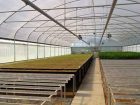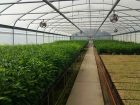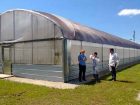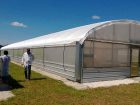
Features
Screens
Structures & Equipment
Which Shading Is The Winner in Florida Trials?
Diffused light results in more active leaves and better usage of light.
March 1, 2016 By Mauricio Manotas
March 2016 — When it comes to shading, which type performs best in greenhouses? Two recent studies conducted in Florida set out to find the answer by comparing the properties of three 60 per cent shades commonly used for nursery and greenhouse production.
Standard black and metallic external shades often spread light inconsistently, causing some plants to receive more light than others, requiring crops to be moved regularly. In contrast, light-diffusing white shades allow light to penetrate deeper and more consistently, promoting even plant growth and less handling of the crop. This enhanced diffused light generates potential crop density increases – maximizing your profitability.
The aim of the two Florida studies – conducted by the University of Florida and at Brite Leaf Citrus Nursery – was to investigate if it is possible to lower air and leaf temperature and improve crop quality using a white light-diffusing open exterior shade compared to metallic and black shades.
In a trial performed at the University of Florida’s Gulf Coast Research and Education Centre, 12 metal-frame enclosures were clad with standard
6 mil clear polyethylene (poly) film.
Sixty per cent shade treatments, including a 60 per cent black shade (Shade Rite), 60 per cent metallic shade (Aluminet) and a 60 per cent white diffusive shade (Svensson 6420 Harmony O E) were randomly assigned and placed over the poly film. Interior ornamental plants (Dypsis lutescens or areca palm and Spathiphyllum spp. or peace lily) were placed in each enclosure. In addition to PAR, air temperature and relative humidity, plant-based measurements were included in the study.
In a separate trial at Brite Leaf Citrus Nursery in Lake Panasoffkee, Florida, two closed structure greenhouses with transparent double poly coverings and nets on the gables and sidewalls were equipped with a 50 per cent diffusive shade (Harmony 5120 O E) and a 50 per cent metallic Aluminet shade.
HIGHER LIGHT, LOWER TEMPERATURES
Exposing plants to high temperatures leads to plant stress such as stomatal closure and reduction in net CO2 assimilation rate, growth and yield. If leaf temperatures are reduced, the plant will be less stressed and net CO2 assimilation rate and growth will be closer to its optimal point. Increased scattering of light generally increases the radiation use efficiency of a plant.
On the other hand, if light reduction is too excessive, net CO2 assimilation will become light limited and photosynthetic productivity will be reduced. Shading may also lead to changes in plant morphology and vegetative growth.
Both studies showed that the greenhouse and enclosures equipped with the open structure white light-diffusing Harmony shades had higher light levels and lower temperatures than the black shade and the metallic shade. Specifically, 15 per cent more PAR-light than black shade and eight per cent more PAR-light than the metallic Aluminet shade.
The Brite Leaf greenhouse with the fixed light-diffusing shade stayed 2.5 C cooler than the greenhouse with a fixed metallic shade. Climate data showed that every day during June and July the air temperatures were lower in the house with diffusive shade screens.
University of Florida researchers observed similar results: enclosures with the diffusive Harmony shade were 5 C cooler than black shade and 2.5 C cooler than metallic shade. Peak temperatures were lowered from above 40 C to 35 C. The study also recorded a lowering of leaf and soil temperatures in the diffusive screen house.
August and September had similar patterns to June and July regarding light and temperature. The differences in temperatures were smaller during August, and then the difference in temperatures increased again in September. Scientists surmise this could be due to heavy rainfall in August.
In the Photos A-B series: To the left, a greenhouse equipped with Metallic 50 per cent Aluminet shade, to the right greenhouse equipped with 50 per cent light-diffusive white Harmony 5120 O E shade. Shade spots are clearly visible in the greenhouse at left; in the right greenhouse shade there are little to no shade spots as a result of light diffusive shade.
In the Photos C-D series: A trial at Brite Leaf Citrus Nursery in Florida compared temperatures, light levels and relative humidity of 50 per cent metallic shade versus 50 per cent white light diffusive shade.
WHAT DOES THIS MEAN FOR GROWERS?
Based on the results, growers would experience the following benefits when selecting a light-diffusing shade screen:
- Diffused light – More light all over the crop results in an increase in radiation use efficiency, more effective photosynthesis and therefore faster and improved growth.
- Reduced average temperatures – Citrus have limited growth above 34 C. If temperatures, on an average, are reduced from above 35 C to below 35 C, the result is an increase in the net CO2 assimilation rate and higher plant growth/yield.
- Reduced peak temperatures from 40 C to 35 C. During hot days with a lot of radiation, the temperatures in the greenhouse easily exceed 40 C under aluminum. At temperatures this high, the citrus plant becomes heat stressed. If peak temperatures are lowered, the plants become less heat stressed.
- Lower temperatures in the greenhouse may potentially lead to less use of water.
- Lower temperatures in general mean a more comfortable climate to work in.
- Better growth consistency – All plants get the same amount of light. Less frequent plant handling reduces labour intensities.
- Stronger and healthier plants – Light reaches deeper into each plant.
Mauricio Manotas is president of Ludvig Svensson, Inc. He can be reached at 704-357-0457, or Mauricio.Manotas@ludvigsvensson.com.
Print this page



